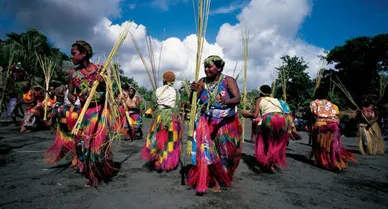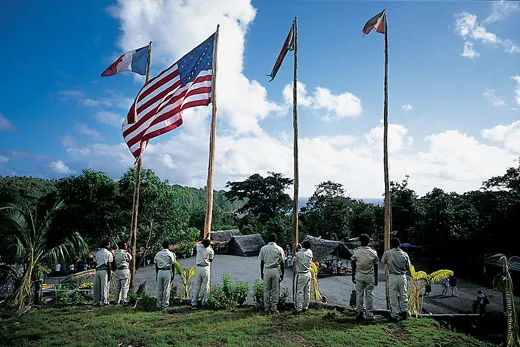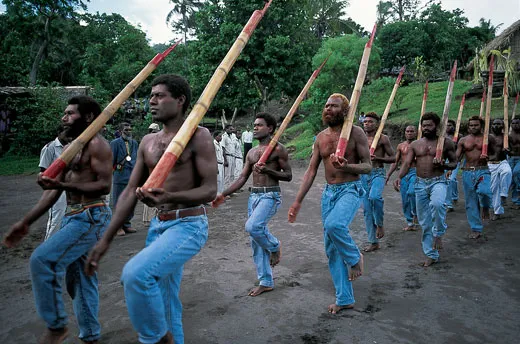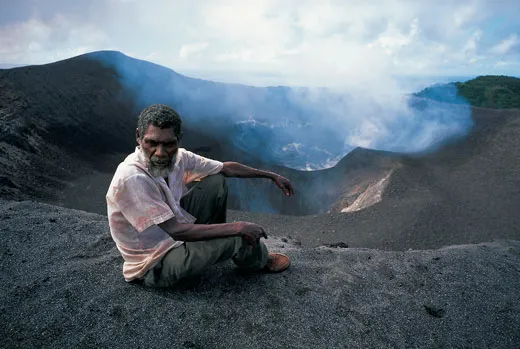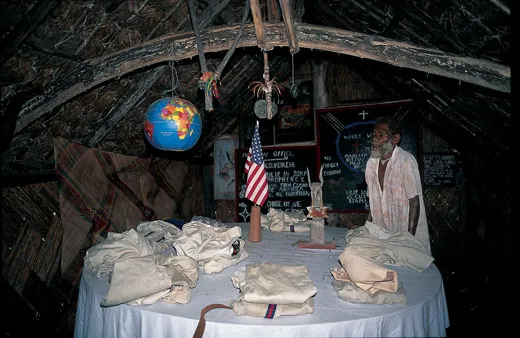In John They Trust
South Pacific villagers worship a mysterious American they call John Frum - believing he’ll one day shower their remote island with riches
In the morning heat on a tropical island halfway across the world from the United States, several dark-skinned men—clad in what look to be U.S. Army uniforms—appear on a mound overlooking a bamboo-hut village. One reverently carries Old Glory, precisely folded to reveal only the stars. On the command of a bearded “drill sergeant,” the flag is raised on a pole hacked from a tall tree trunk. As the huge banner billows in the wind, hundreds of watching villagers clap and cheer.
Chief Isaac Wan, a slight, bearded man in a blue suit and ceremonial sash, leads the uniformed men down to open ground in the middle of the village. Some 40 barefoot "G.I.’s" suddenly emerge from behind the huts to more cheering, marching in perfect step and ranks of two past Chief Isaac. They tote bamboo “rifles” on their shoulders, the scarlet tips sharpened to represent bloody bayonets, and sport the letters “USA,” painted in red on their bare chests and backs.
This is February 15, John Frum Day, on the remote island of Tanna in the South Pacific nation of Vanuatu. On this holiest of days, devotees have descended on the village of Lamakara from all over the island to honor a ghostly American messiah, John Frum. “John promised he’ll bring planeloads and shiploads of cargo to us from America if we pray to him,” a village elder tells me as he salutes the Stars and Stripes. “Radios, TVs, trucks, boats, watches, iceboxes, medicine, Coca-Cola and many other wonderful things.”
The island’s John Frum movement is a classic example of what anthropologists have called a “cargo cult”—many of which sprang up in villages in the South Pacific during World War II, when hundreds of thousands of American troops poured into the islands from the skies and seas. As anthropologist Kirk Huffman, who spent 17 years in Vanuatu, explains: “You get cargo cults when the outside world, with all its material wealth, suddenly descends on remote, indigenous tribes.” The locals don’t know where the foreigners’ endless supplies come from and so suspect they were summoned by magic, sent from the spirit world. To entice the Americans back after the war, islanders throughout the region constructed piers and carved airstrips from their fields. They prayed for ships and planes to once again come out of nowhere, bearing all kinds of treasures: jeeps and washing machines, radios and motorcycles, canned meat and candy.
But the venerated Americans never came back, except as a dribble of tourists and veterans eager to revisit the faraway islands where they went to war in their youth. And although almost all the cargo cults have disappeared over the decades, the John Frum movement has endured, based on the worship of an American god no sober man has ever seen.
Many Americans know Vanuatu from the reality TV series “Survivor,” though the episodes shot there hardly touched on the Melanesian island nation’s spectacular natural wonders and fascinating, age-old cultures. Set between Fiji and New Guinea, Vanuatu is a Y-shaped scattering of more than 80 islands, several of which include active volcanoes. The islands were once home to fierce warriors, among them cannibals. Many inhabitants still revere village sorcerers, who use spirit-possessed stones in magic rituals that can lure a new lover, fatten a pig or kill an enemy.
Americans with longer memories remember Vanuatu as the New Hebrides—its name until its independence from joint British and French colonial rule in 1980. James Michener’s book Tales of the South Pacific, which spawned the musical South Pacific, grew out of his experiences as an American sailor in the New Hebrides in World War II.
My own South Pacific experience, in search of John Frum and his devotees, begins when I board a small plane in Vanuatu’s capital, Port-Vila. Forty minutes later, coral reefs, sandy beaches and green hills announce Tanna Island, about 20 miles long and 16 miles at its widest point, with a population of around 28,000. Climbing into an ancient jeep for the drive to Lamakara, which overlooks Sulphur Bay, I wait while Jessel Niavia, the driver, starts the vehicle by touching together two wires sticking out from a hole under the dashboard.
As the jeep rattles up a steep slope, the narrow trail slicing through the jungle’s dense green weave of trees and bushes, Jessel tells me that he is the brother-in-law of one of the cult’s most important leaders, Prophet Fred—who, he adds proudly, “raised his wife from the dead two weeks ago.”
When we reach the crest of a hill, the land ahead falls away to reveal Yasur, Tanna’s sacred volcano, a few miles to the south, its ash-coated slopes nudging the shoreline at Sulphur Bay. Dark smoke belches from its cone. “‘Yasur’ means God in our language,” Jessel murmurs. “It’s the house of John Frum.”
“If he’s an American, why does he live in your volcano?” I wonder aloud.
“Ask Chief Isaac,” he says. “He knows everything.”
Dotting the dirt road are small villages where women with curly, bubble-shaped hair squat over bundles of mud-coated roots called kava, a species of pepper plant and a middling narcotic that is the South Pacific’s traditional drug of choice. Connoisseurs say that Tanna’s kava is the strongest of all. Jessel buys a bundle of roots for 500 vatu, about $5. “We’ll drink it tonight,” he says with a grin.
For as long as Tanna’s inhabitants can remember, island men have downed kava at sunset each day in a place off-limits to women. Christian missionaries, mostly Presbyterians from Scotland, put a temporary stop to the practice in the early 20th century, also banning other traditional practices, or “kastom,” that locals had followed faithfully for millennia: dancing, penis wrapping and polygamy. The missionaries also forbade working and amusement on Sundays, swearing and adultery. In the absence of a strong colonial administrative presence, they set up their own courts to punish miscreants, sentencing them to forced labor. The Tannese seethed under the missionaries’ rules for three decades. Then, John Frum appeared.
The road drops steeply through more steamy jungle to the shoreline, around the point from Yasur, where I will stay in a hut on the beach. As the sun sets beyond the rain-forest- covered mountains that form Tanna’s spine, Jessel’s brother, Daniel Yamyam, arrives to fetch me. He has the soft-focus eyes and nearly toothless smile of a kava devotee. Daniel was once a member of Vanuatu’s Parliament in Port-Vila, and his constituents included John Frum followers from what was then the movement’s stronghold, Ipikil, on Sulphur Bay. “I’m now a Christian, but like most people on Tanna, I still have John Frum in my heart,” he says. “If we keep praying to John, he’ll come back with plenty of cargo.”
Daniel leads me to his village nakamal, the open ground where the men drink kava. Two young boys bend over the kava roots Jessel had purchased, chewing chunks of them into a stringy pulp. “Only circumcised boys who’ve never touched a girl’s body can make kava,” Daniel tells me. “That ensures that their hands are not dirty.”
Other boys mix water with the pulp and twist the mixture through a cloth, producing a dirty-looking liquid. Daniel hands me a half-coconut shell filled to the brim. “Drink it in one go,” he whispers. It tastes vile, like muddy water. Moments later my mouth and tongue turn numb.
The men split into small groups or sit by themselves, crouching in the darkness, whispering to each other or lost in thought. I toss back a second shell of the muddy mix, and my head tugs at its mooring, seeking to drift away into the night.
Yasur rumbles like distant thunder, a couple of miles over the ridge, and through the trees I glimpse an eerie red glow at its cone. In 1774, Capt. James Cook was lured ashore by that same glow. He was the first European to see the volcano, but local leaders banned him from climbing to the cone because it was taboo. Daniel assures me the taboo is no longer enforced. “Go with Chief Isaac,” he advises. “You can ask him tomorrow.”
After I drink my third shell of kava, Daniel peers into my undoubtedly glazed eyes. “I’d better take you back,” he says. By the seaside at my hut, I dance unsteadily to the rhythm of the waves as I try to pluck the shimmering moon from the sky and kiss it.
The next morning, I head to Lamakara to talk to Chief Isaac. Surrounded by an eerie doomsday moonscape of volcanic ash, Yasur looms behind the village. But at only 1,184 feet high, the sacred volcano has none of the majesty of, say, Mount Fuji; instead, its squat shape reminds me of a pugnacious bulldog standing guard before its master’s house. My driver points at the cone. “Haus blong John Frum,” he says in pidgin English. It’s John Frum’s house.
In the village dozens of cane huts, some with rusting tin roofs, encircle an open ceremonial dancing ground of impacted ash and the mound where the American flag flies each day, flanked by the much smaller flags of Vanuatu, ex-colonial ruler France and the Australian Aborigines, whose push for racial equality the villagers admire. Clearly, John Frum has yet to return with his promised cargo because Lamakara is dirt poor in consumer goods. But island men, wrapped in cloth known as lava-lava, women in large flowered dresses and mostly barefoot children in T-shirts appear healthy and seem happy. That’s no surprise: like many South Pacific coastal villages, it’s a place where coconuts drop by your side as you snooze. Yams, taro, and pineapples and other fruit thrive in the fertile volcanic soil, and plump pigs sniff around the village for scraps. Tasty fruit bats cling upside down in nearby trees.
Chief Isaac, in an open-neck shirt, green slacks and cloth shoes, greets me on the mound and leads me into a hut behind the flagpoles: the John Frum inner sanctum, off-limits to all but the cult’s senior leaders and, it seems, male visitors from abroad. “Office blong me,” he says with a smile as we enter.
The hut is dominated by a round table displaying a small U.S. flag on a pedestal, a carved bald eagle and imitation U.S. military uniforms neatly folded and placed in a circle, ready for use on John Frum Day in a little more than a week. Above, suspended by vine from a beam, hangs a globe, a stone ax and a pair of green stones carved into circles the size of a silver dollar. “Very powerful magic,” the chief says as he points to the stones. “The gods made them a long time ago.”
Written on a pair of blackboards is a plea that John Frum’s followers lead a kastom life and that they refrain from violence against each other. One of the blackboards bears a chalked red cross, probably copied from U.S. military ambulances and now an important symbol for the cult.
“John Frum came to help us get back our traditional customs, our kava drinking, our dancing, because the missionaries and colonial government were deliberately destroying our culture,” Chief Isaac says, his pidgin English translated by Daniel.
“But if John Frum, an American, is going to bring you modern goods, how does that sit with his wish that you lead a kastom life?” I ask.
“John is a spirit. He knows everything,” the chief says, slipping past the contradiction with the poise of a skilled politician. “He’s even more powerful than Jesus.”
“Have you ever seen him?”
“Yes, John comes very often from Yasur to advise me, or I go there to speak with John.”
“What does he look like?”
“An American!”
“Then why does he live in Yasur?”
“John moves from America to Yasur and back, going down through the volcano and under the sea.”
When I mention Prophet Fred, anger flares in Chief Isaac’s eyes. “He’s a devil,” he snarls. “I won’t talk about him.”
What about your visit to the United States in 1995? I ask. What did you think of your religion’s heaven on earth? He raises his hands apologetically. “I have much to do today. I’ll tell you about it another time.” On the way back to my hut, it occurs to me that I forgot to ask him to take me to the volcano.
Chief Isaac and other local leaders say that John Frum first appeared one night in the late 1930s, after a group of elders had downed many shells of kava as a prelude to receiving messages from the spirit world. “He was a white man who spoke our language, but he didn’t tell us then he was an American,” says Chief Kahuwya, leader of Yakel village. John Frum told them he had come to rescue them from the missionaries and colonial officials. “John told us that all Tanna’s people should stop following the white man’s ways,” Chief Kahuwya says. “He said we should throw away their money and clothes, take our children from their schools, stop going to church and go back to living as kastom people. We should drink kava, worship the magic stones and perform our ritual dances.”
Perhaps the chieftains in their kava reveries actually experienced a spontaneous vision of John Frum. Or perhaps the apparition has more practical roots. It’s possible that local leaders conceived of John Frum as a powerful white-skinned ally in the fight against the colonials, who were attempting to crush much of the islanders’ culture and prod them into Christianity. In fact, that view of the origins of the cult gained credence in 1949, when the island administrator, Alexander Rentoul, noting that “frum” is the Tannese pronunciation of “broom,” wrote that the object of the John Frum movement “was to sweep (or broom) the white people off the island of Tanna.”
Whatever the truth, John Frum’s message struck a chord. Villagers on Tanna began throwing their money into the sea and killing their pigs for grand feasts to welcome their new messiah. Colonial authorities eventually struck back, arresting the movement’s leaders—including Chief Isaac’s father, Chief Nikiau. They were shipped to a prison at Port-Vila in 1941, their subsequent years behind bars earning them status as the John Frum movement’s first martyrs.
The cult got its biggest boost the following year, when American troops by the thousands were dispatched to the New Hebrides, where they built large military bases at Port-Vila and on the island of Espíritu Santo. The bases included hospitals, airstrips, jetties, roads, bridges and corrugated-steel Quonset huts, many erected with the help of more than a thousand men recruited as laborers from Tanna and other parts of the New Hebrides—among them Chief Kahuwya.
Where the U.S. armed forces go, so go the legendary PXs, with their seemingly endless supply of chocolate, cigarettes and Coca-Cola. For men who lived in huts and farmed yams, the Americans’ wealth was a revelation. The troops paid them 25 cents a day for their work and handed out generous amounts of goodies.
The Americans’ munificence dazzled the men from Tanna, as did the sight of dark-skinned soldiers eating the same food, wearing the same clothes, living in similar huts and tents and operating the same high-tech equipment as white soldiers. “In kastom, people sit together to eat,” says Kirk Huffman, who was the curator of Vanuatu’s cultural center during his years in the island nation. “The missionaries had angered the Tannese by always eating separately.”
It seems this is when the legend of John Frum took on a decidedly American character. “John Frum appeared to us in Port-Vila,” Chief Kahuwya says, “and stayed with us throughout the war. John was dressed in all white, like American Navy men, and it was then we knew John was an American. John said that when the war was over, he’d come to us in Tanna with ships and planes bringing much cargo, like the Americans had in Vila.”
In 1943, the U.S. command, concerned about the movement’s growth, sent the USS Echo to Tanna with Maj. Samuel Patten on board. His mission was to convince John Frum followers that, as his report put it, “the American forces had no connection with Jonfrum.” He failed. At war’s end, the U.S. military unwittingly enhanced the legend of their endless supply of cargo when they bulldozed tons of equipment—trucks, jeeps, aircraft engines, supplies—off the coast of Espíritu Santo. During six decades in the shallows, coral and sand have obscured much of the watery grave of war surplus, but snorkelers can still see tires, bulldozers and even full Coke bottles. The locals wryly named the place Million Dollar Point.
After the war, when they returned home from Port-Vila to their huts, the Tanna men were convinced that John Frum would soon join them, and hacked a primitive airstrip out of the jungle in the island’s north to tempt the expected American planes from the skies. Across the South Pacific, thousands of other cargo cult followers began devising similar plans—even building bamboo control towers strung with rope and bamboo aerials to guide in the planes. In 1964, one cargo cult on New Hanover Island in Papua New Guinea offered the U.S. government $1,000 for Lyndon Johnson to come and be their paramount chief. But as the years passed with empty skies and seas, almost all the cargo cults disappeared, the devotees’ hopes crushed.
At Sulphur Bay the faithful never wavered. Each Friday afternoon, hundreds of believers stream across the ash plain below Yasur, coming to Lamaraka from villages all over Tanna. After the sun goes down and the men have drunk kava, the congregation gathers in and around an open hut on the ceremonial ground. As light from kerosene lamps flickers across their faces, they strum guitars and homemade ukuleles, singing hymns of John Frum’s prophecies and the struggles of the cult’s martyrs. Many carry the same plea: “We’re waiting in our village for you, John. When are you coming with all the cargo you promised us?”
Threaded among the singers’ perfect harmonies is a high-pitched Melanesian keening that hones each hymn with a yearning edge. I look around in vain for Chief Isaac until a senior man in the cult whispers that after drinking kava, Isaac has disappeared among the darkened trees to talk to John Frum. The weekly service doesn’t end until the sun comes back up, at seven the next morning.
The John Frum movement is following the classic pattern of new religions,” says anthropologist Huffman. Schisms split clumps of faithful from the main body, as apostates proclaim a new vision leading to sacrilegious variants on the creed’s core beliefs.
Which explains Prophet Fred, whose village, Ipikil, is nestled on Sulphur Bay. Daniel says that Prophet Fred split with Chief Isaac in 1999 and led half of the believer villages into his new version of the John Frum cult. “He had a vision while working on a Korean fishing boat in the ocean,” Daniel says. “God’s light came down on him, and God told him to come home and preach a new way.” People believed that Fred could talk to God after he predicted, six years ago, that Lake Siwi would break its natural dam and flood into the ocean. “The people living around the lake [on the beach beneath the volcano] moved to other places,” says Daniel. “Six months later, it happened.”
Then, almost two years ago, Prophet Fred’s rivalry with Chief Isaac exploded. More than 400 young men from the competing camps clashed with axes, bows and arrows and slingshots, burning down a thatched church and several houses. Twenty-five men were seriously injured. “They wanted to kill us, and we wanted to kill them,” a Chief Isaac loyalist says.
A few days before Lamakara’s annual John Frum celebration, I visit Prophet Fred’s village—only to find that he’s gone to the island’s northern tip to preach, most likely to avoid the celebrations. Instead, I meet his senior cleric, Maliwan Tarawai, a barefoot pastor carrying a well-thumbed Bible. “Prophet Fred has called his movement Unity, and he’s woven kastom, Christianity and John Frum together,” Tarawai tells me. The American messiah is little more than a figurehead in Fred’s version, which bans the display of foreign flags, including Old Glory, and forbids any talk of cargo.
All morning I watch as vocalists with a string band sing hymns about Prophet Fred while several wild-eyed women stumble around in what appears to be a trance. They faith-heal the sick by clutching the ailing area of the body and praying silently to the heavens, casting out demons. Now and then they pause to clutch with bony fingers at the sky. “They do this every Wednesday, our holy day,” Tarawai explains. “The Holy Spirit has possessed them, and they get their healing powers from him and from the sun.”
Back in Lamakara, John Frum Day dawns warm and sticky. After the flag raising, Chief Isaac and other cult leaders sit on benches shaded by palm fronds as several hundred followers take turns performing traditional dances or modern improvisations. Men and boys clad in stringy bark skirts stride onto the dancing ground clutching replicas of chain saws carved from jungle boughs. As they thump their feet in time to their own singing, they slash at the air with the make-believe chain saws. “We’ve come from America to cut down all the trees,” they sing, “so we can build factories.”
On the day before I leave Tanna, Chief Isaac and I finally climb the slippery ash slopes of Yasur, the ground trembling about every ten minutes with each thunderous explosion from within the volcano’s crater. Every ear-humming bang sends a huge plume of potentially killer gas high into the sky, a mingling of sulfur dioxide, carbon dioxide and hydrogen chloride.
Darkness brings a spectacular display, as molten lava explodes from the crater’s vents, shooting into the air like giant Roman candles. Two people were killed here by “lava bombs,” or falling chunks of volcanic rock, in 1994. Chief Isaac leads me to a spot on the crumbling rim, away from the drift of the hazardous gas but still within reach of the incandescent bombs the unpredictable volcano bursts into the air.
The chief tells me about his trip to the United States in 1995, and shows faded pictures of himself in Los Angeles, outside the White House and with a drill sergeant at a military base. He says he was astonished by the wealth of the United States, but surprised and saddened by the poverty he saw among white and black Americans alike, and by the prevalence of guns, drugs and pollution. He says he returned happily to Sulphur Bay. “Americans never show smiling faces,” he adds, “and so it seems they always think that death is never far away.”
When I ask what he most wants from America, the simplicity of his request moves me: “A 25-horsepower outboard motor for the village boat. Then we can catch much fish in the sea and sell them in the market so that my people can have a better life.”
As we look down into John Frum’s fiery Tanna home, I remind him that not only does he not have an outboard motor from America, but that all the devotees’ other prayers have been, so far, in vain. “John promised you much cargo more than 60 years ago, and none has come,” I point out. “So why do you keep faith with him? Why do you still believe in him?”
Chief Isaac shoots me an amused look. “You Christians have been waiting 2,000 years for Jesus to return to earth,” he says, “and you haven’t given up hope.”
